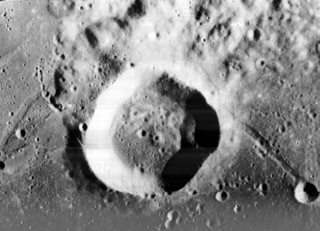
Adams is a lunar impact crater that is located in the rugged southeastern section of the Moon, near the lunar limb. It lies just to the southwest of the crater Legendre. To the northwest are the craters Hase and Petavius, and to the southwest is Furnerius. To the southwest of Adams is a system of rilles designated the Rimae Hase. The longest of these rilles follows a course to the southeast.

Appleton is a heavily eroded lunar impact crater that lies in the northern hemisphere on the far side of the Moon. To the northwest are the craters Von Neumann and Campbel. The smaller Golovin lies to the northeast, while further to the southwest is the Mare Moscoviense.

Armiński is a small lunar impact crater that is located on the far side of the Moon, to the northeast of the large walled basin Gagarin. To the northwest of Armiński is the crater Beijerinck, and to the southeast lies Cyrano.

Asclepi is a heavily eroded lunar impact crater that lies in the rugged southern highlands of the Moon. The outer rim has been worn down and rounded by many millions of years of subsequent impacts, so that it is now nearly level with the surrounding terrain. As a result, the crater is now little more than a depression in the surface. The interior is nearly flat and relatively featureless.

Byrd is an irregular lunar impact crater that is located near the north pole of the Moon. The north rim of Byrd is nearly connected to the crater Peary, a formation that is adjacent to the pole. The smaller crater Gioja is attached to the remains of the southwest rim.

Bergstrand is a lunar impact crater that lies on the far side of the Moon. It is located just to the southeast of the prominent crater Aitken, and northeast of the walled plain Vertregt.

Dawson is a lunar impact crater that lies on the southern hemisphere on the far side of the Moon. It lies across a crater triplet: the southeast rim is intruding into the crater Alekhin; the northwest rim also intrudes into the larger satellite crater Dawson V, and the northeast rim is attached to the comparably sized Dawson D. To the south of this formation is the large crater Zeeman. West of Dawson is the crater Crommelin, and to the north lies Fizeau.

Fizeau is a prominent lunar impact crater that is located on the far side of the Moon, in the southern hemisphere. Nearby craters of note include Minkowski to the west-northwest, and Eijkman to the southwest.

Boltzmann is an old lunar impact crater that is located along the southern limb of the Moon, in the vicinity of the south pole. At this location the crater is viewed from the side from Earth, and so not much detail can be seen. It is located to the north of the walled plain Drygalski, and to the west of the crater Le Gentil.

Breislak is a lunar impact crater that lies within one crater diameter north-northwest of the crater Baco, in the southern part of the Moon. To the north-northwest is the crater Barocius, and to the west lies Clairaut. This crater was named in honor of geologist Scipione Breislak.

Bhabha is a lunar impact crater that is located in the southern part of the Moon's far side. It is nearly attached to the southeast rim of the larger crater Bose, and the outer rampart of that crater has produced a slight inward bulge along the northwest face of Bhabha. Other nearby craters of note include Stoney to the east, and Bellinsgauzen to the south.

Belopol'skiy is a lunar impact crater that is located on the far side of the Moon. It lies to the west of the crater Houzeau, and northeast of Strömgren. Just to the northwest of Belopol'skiy is the crater Ioffe.

Carnot is a large crater in the northern part of the Moon's far side. It intrudes into the southern rim of the huge walled plain Birkhoff. To the west-southwest of Carnot is the crater Paraskevopoulos.

Chappell is a lunar impact crater that is located on the far side of the Moon, in the northern hemisphere just to the north of the crater Debye. This feature is located in a heavily bombarded section of the surface, and much of the outer rim of the crater is overlain by many smaller craters. The northern rim in particular has been almost completely disintegrated, while small craters also overlie the rim to the northwest and southeast. What remains of the rim forms a rounded, somewhat irregular edge to the crater depression.
Dove is a small lunar impact crater that is located in the rugged lunar highlands in the southeastern part of the Moon. It lies to the north of the prominent crater Pitiscus.

Fraunhofer is a lunar impact crater that is located just to the south-southwest of the walled plain Furnerius, in the southeastern part of the Moon. This crater appears foreshortened when viewed from the Earth, and is actually nearly circular.

Donner is a lunar impact crater on the far side of the Moon. It is located just to the northeast of the Mare Australe, behind the southeastern limb of the Moon. During favorable librations this part of the lunar surface can be brought into view of the Earth, but the site is viewed from the edge and so not much detail can be seen.

Eötvös is the remains of a lunar impact crater on the far side of the Moon. It lies to the north-northwest of the walled plain Roche, and east-southeast of the equally ruined Bolyai.

Fowler is a large lunar impact crater that lies in the northern hemisphere on the Moon's far side. It lies to the south-southwest of the crater Esnault-Pelterie, and north of Gadomski. Overlying the eastern rim and intruding into the interior is Von Zeipel.

Weber is a lunar impact crater on the far side of the Moon, and it cannot be viewed directly from the Earth's surface. This crater is attached to the northwest outer rim of the larger crater Sarton. About two crater diameters to the northwest is the eroded Kramers.
























